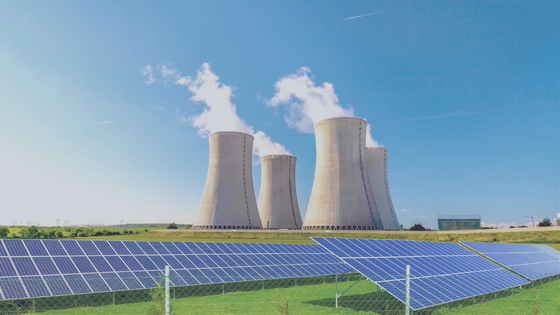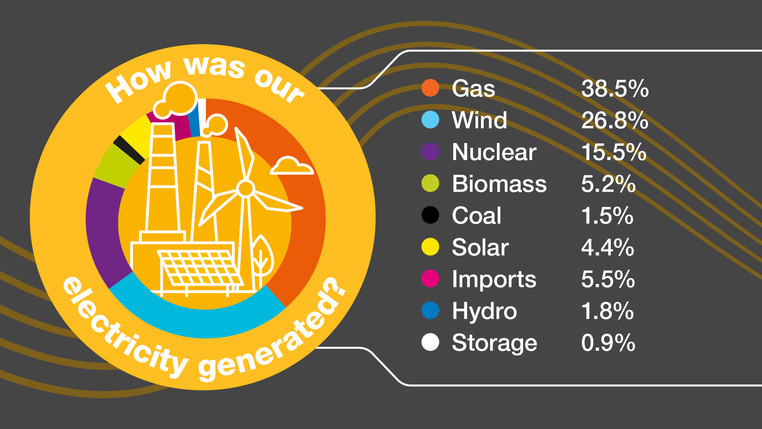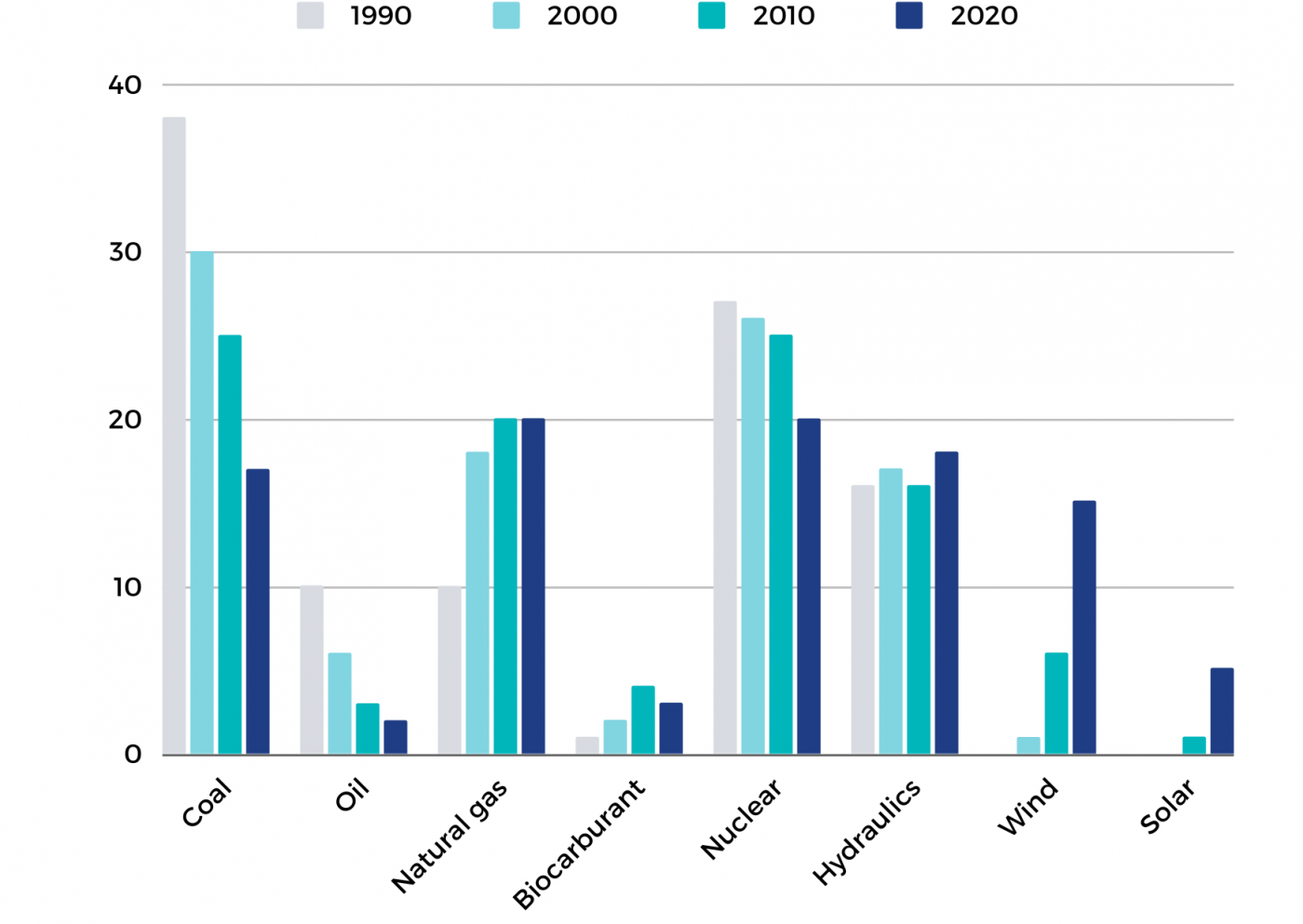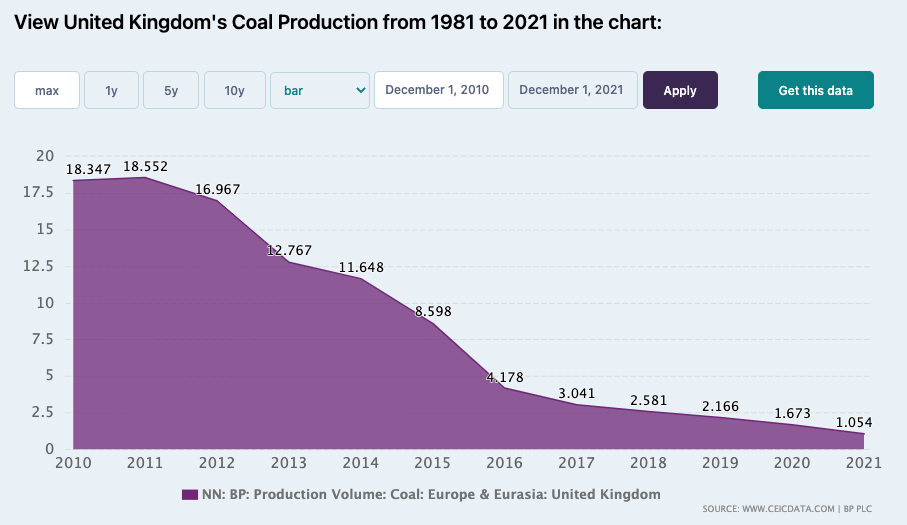What energy sources are used in the UK to produce electricity? According to the BEIS (2022) the UK’s energy mix consists of primary oil (crude oil and Natural Gas Liquids), natural gas, primary electricity (consisting of nuclear, wind, solar and hydro) bioenergy and waste, and coal.
In recent years, renewable energies have taken on an increasingly important role in energy production in the country. In 2022, the energy sector had an exceptional year, marked by an unprecedented level of energy production from renewable sources.
Institutional support, lower costs, subsidies and emission reduction commitments have contributed to the rapid expansion of clean energy and the shift away from other more polluting energies.
This article delves into the electricity mixes of both the UK and Europe, analysing how they have evolved over recent years through a comparative analysis.
The energy mix refers to the share of different energy sources that produce electricity or provide energy for different purposes. However, the energy mix is more cross-cutting and considers the sources used to produce all types of energy, such as fuels (coal, oil, gas) and renewables.
It is crucial to bear this in mind since when we consider transport fuels, for instance, oil continues to be a predominant source, highlighting the need to shift towards more sustainable alternatives.
Why understand the Energy Mix?
Let’s take the example of a day when energy demand is at its highest… The industrial sector is producing, the tertiary sector is in full activity, and universities and shops are open. What to do when all these sectors need energy at the same time and the electricity production network is stretched?
In this situation, we can consider two options:
- Combine energy from renewable and non-renewable sources to ensure supply for all.
- Limit the production of energy from renewable sources only, by setting limits and cuts in supply.
It’s not surprising that, in such a scenario, the first option prevails. After all, even if we strive to be more sustainable, we cannot completely forego electricity. Rather, it’s about finding a balance.
Understanding the energy mix is crucial for several reasons. Firstly, it allows us to understand the energy sources used to generate electricity, heat, and power for businesses. This knowledge can help stakeholders make more informed decisions about their energy consumption and be more conscious of their environmental impact.
Secondly, it can drive the transition towards cleaner and more sustainable energy sources. By understanding which sources are currently being used and which ones have the potential for growth, opportunities to invest in renewable energy infrastructure and technologies can be identified.
Finally, understanding the energy mix is useful for energy policies and regulations. Indeed, governments can use this information to set targets for reducing carbon emissions and increasing the share of renewable energy in the energy mix. This can help to drive innovation and investment in new technologies and infrastructures, and create opportunities for businesses and investors in the energy sector.
To sum up, understanding the energy mix can help policymakers, businesses, and individuals make informed decisions about energy use and contribute to the transition towards a more sustainable and low-carbon energy system. Let us now have a look at the data for electricity generation in the United Kingdom.
Energy Mix of Electricity Generation in the UK
Throughout the past year, gas has remained a key contributor to supplying the majority of the electricity used in Great Britain. It is still true in 2022 as it is the main source of electricity (38.5%) generated. However, we note substantial transformations in other technologies over the course of 2022 including wind, in second position, which accounted for 26.8% of electricity generated and nuclear, in third, which fell slightly to 15.5%.
Another source of energy also helps to ensure a country’s independence is renewable energy. Renewable energy plays an important role in controlling the UK’s energy bill in the long term. Furthermore, the UK government has set ambitious targets for renewable energy usage, aiming for at least 50% of its electricity generation to come from renewable sources by 2030, and achieving net-zero carbon emissions by 2050. These targets have spurred investment and innovation in the renewable energy sector, as the country moves towards a more sustainable and low-carbon future, which can explain why Wind was the second largest contributor to electricity generated. In the UK, there has been a surge in the proportion of electricity obtained from renewable sources, reaching an all-time high in 2022, whereby 40% of the country’s total electricity production originated from renewable sources.
Renewables’ triumph in the UK has led the nation to achieve the remarkable feat of becoming a net exporter of electricity for the first time in over ten years. In 2022, electricity exports surged fourfold, totalling 17.2 TWh, generating approximately £3.1bn for the UK economy. The country exported a net total of 1.9 TWh, a dramatic change in electricity trade from the previous year when Britain imported a net total of 22.9 TWh.
What is the difference between renewable and non-renewable Energy?
We often hear about renewable energies and their rise in national and global production and consumption. But do you know them all?
Here are the main families of renewable energies used to produce electricity:
- Wind energy (onshore and offshore)
- Solar energy (photovoltaic, thermal and thermodynamic)
- Hydraulic energy
- Biomass
Note that some of these renewable energies also allow the production of heat. This is the case with geothermal energy, for example.
Renewable energy comes from sources that can be naturally replenished or renewed over time, such as solar, wind, hydropower, geothermal, and biomass. Non-renewable energy, on the other hand, comes from sources that are finite and will eventually run out, such as fossil fuels like coal, oil, and natural gas.
Renewable energy is considered more sustainable because it has a lower impact on the environment, reduces greenhouse gas emissions, and helps to mitigate climate change. Non-renewable energy sources are responsible for the majority of global greenhouse gas emissions and contribute to air and water pollution, environmental degradation, and health issues.
It is also important not to confuse renewable energy with clean energy. They are two very similar terms, but they are not 100% interchangeable. Renewable energy as we have seen above is energy produced in nature and does not run out (such as solar or wind energy). Clean energy is considered to be energy that does not contribute to carbon emissions, although it is not unlimited.
Thus, photovoltaic and wind energy are considered both renewable and clean. Although the manufacturing of panels and turbines is polluting… Nuclear energy is considered clean by some sectors because it does not emit polluting gases into the atmosphere, although it has its own environmental risks. The definition is therefore quite complex.
Energy Mix of Electricity generation in Europe
Renewable energies are growing all over the world and Europe is pushing for ever-cleaner electricity production. However, each country has a certain amount of independence and, depending on the country, the disparities are significant. In this sense, the International Energy Agency (IEA) provides data for each country to get an overview of their electricity mix.
In Germany, for example, coal is still very much a part of the energy mix, accounting for 30%. Other countries, such as Poland, also rely mainly on coal, accounting for almost 70% of the energy mix.
In Italy, the share of natural gas is higher and the share of wind power is lower. In Denmark, almost 50% of the energy comes from wind power. In Austria, hydroelectricity is the primary source of energy.
In Spain, since 2020, the share of renewable energy has been approaching 50%. With variations throughout the year, wind energy is leading the way in production, overtaking nuclear energy.
Looking at Europe as a whole, a 40% share of renewable energy production was reached in 2020 according to Eurostat data. This is followed by nuclear energy (30%), fossil fuels and natural gas.
This graph shows the weight of each energy source in Europe between 1990 and 2020. On the left, you can see the percentages that each source represents. Coal and oil have drastically declined over this period of time, whereas other sources such as gas and renewables (wind, solar, hydraulics) have increased.
Innovation and change of Electricity generation Model
Utilities that produce energy combine known methods, such as nuclear power generation, and are constantly innovating in the use of new sources and seeking to reduce emissions. In the field of renewable energy, innovation in new methods is constant: offshore wind turbines, floating solar panels, and transparent solar panels on windows, are just a few examples.
Moving away from coal
As these alternative systems grow, methods such as the use of coal to generate electricity are gradually left behind. As shown in this chart, the UK’s coal production has been declining since 2011. This can be explained by the fact that most coal-fired power stations have been dismantled, even though despite opposition from local communities, as well as national and global objections, the UK decided to construct its first new coal mine in 30 years at Whitehaven in Cumbria in December 2022. The coal mine is striving to achieve net-zero emissions in its operations and is anticipated to have a positive impact on the local job market and the broader economy.
Coal as an energy source has only declined in Europe, although since the conflict in Ukraine in 2021, some countries have reactivated these plants to secure their supply at a time when gas imports from Russia have been blocked.
Reduction of centralised Energy production
In order to guarantee the supply of all users, regardless of the energy source they use, the interconnection between large producers, the electricity grid and small producers is necessary.
Energy production and self-consumption are developing with energy communities and small energy producers. Although large organisations remain the main producers, the independent market is developing, which means a progressive decentralisation of the production system.
Over the past few years, the UK has seen a reduction in centralised energy production, as more and more businesses and homeowners turn to renewable energy sources to meet their energy needs. This shift towards decentralised energy production is a significant step towards a more sustainable future, and it is one that is gathering momentum.
One of the main drivers behind this shift is the increasing availability of affordable renewable energy technologies, such as solar panels and wind turbines. These technologies have become more efficient and less expensive in recent years, making them an attractive option for businesses and homeowners looking to reduce their carbon footprint and save money on energy bills.
Another motivation observed is the growing awareness of the need to reduce reliance on fossil fuels. The UK government has set ambitious targets for reducing greenhouse gas emissions, and increasing the use of renewable energy sources is a key part of achieving these objectives
In addition to the environmental benefits, decentralised energy production can also provide a range of economic benefits. For businesses generating their own energy, there is the potential to sell excess energy back to the grid, providing a new source of income. There are also opportunities for job creation in the renewable energy sector, as more and more businesses move towards sustainable energy production.
Despite the many benefits some challenges need to be addressed but overall, the shift towards decentralised energy production in the UK is a positive step in creating a more sustainable future.
The energy storage challenge
Storage is one of the biggest challenges for renewable energy. Although a certain amount of electricity can be stored, it is not yet possible to store it on a large scale.
This is one of the current obstacles to renewables, as they are to some extent “volatile”.
Therefore, storage is essential to be able to keep all the electricity produced during peak hours and to be able to store and distribute it when needed. In this way, all the energy produced by these sources can be used. With the development of larger capacity batteries, the energy produced by renewable energies can be better stored and distributed.
In this sense, Wärtsilä, a Finnish technology conglomerate, has announced its plan to construct a groundbreaking 200MW/400MWh battery energy storage system. This innovative system will aid in harmonising the offshore wind output and contribute towards the UK’s goal of achieving 100% renewable energy. It should be effective in 2024.
Overall, the UK’s energy mix is evolving rapidly as the country works to reduce its carbon emissions and transition to a cleaner energy system. While challenges remain, including the need for new nuclear capacity and the integration of intermittent renewable sources, the country is making significant progress towards a more sustainable energy future.
Regardless of the source, the electricity you receive can be monitored and metered with intelligent energy management systems such as the Dexma platform. If you would like to be kept up to date with our articles, analysis and training, subscribe to our communications here.







